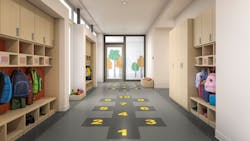The quality of education and student wellness is linked to the design of the built environment. Floors play a significant role in supporting the health and wellness of all educational environments. This is particularly important when one considers that in pre-pandemic America, the average K-12 student spent over 987 hours per year inside school facilities, according to AtikaBox, a facility management software company that focuses on operating and maintaining safe and healthy facilities.
Resilient flooring has been a high-performance mainstay in the educational space for a variety of reasons. Products like sheet vinyl, solid vinyl tile and rubber have long had a reputation for easy maintenance and cleanability, as well as affordability, durability, performance and aesthetics. In recent years, technology has provided means for enhancing the aesthetics of vinyl products while maintaining required performance characteristics. As a result, luxury vinyl tile (LVT) and plank (LVP) products have added even more flooring options for educational product specifiers.
However, even with all of its popularity in the education sector, there are some who will contend that vinyl products may be harmful to children. But today’s manufacturing processes and vinyl chemistry have been advanced over time to produce one of the safest, most environmentally responsible flooring surfaces you can specify.
As schools are opening up and in-person learning is becoming the norm again across much of the U.S., there is an even greater concern emerging about educational wellness with regard to all building materials. Typically, educational facilities utilize hard surface flooring as part of their design; however, for those that include carpet, it is likely that this will be replaced by resilient flooring—rubber sheet/tile or vinyl sheet/tile because of ease of maintenance—including cleaning and disinfection, durability and performance. To that end, here are several factors that architects and interior designers should consider when specifying resilient flooring for educational projects.
Thorough Disinfection
The pandemic has created unique safety issues within primary, college/university and continuing education settings. Based upon the Centers for Disease Control and Prevention (CDC) guidelines, during the pandemic, all public spaces (e.g. schools) have essentially come under the same infection prevention scrutiny for cleaning and disinfecting environmental surfaces as healthcare settings.
Given the increased consciousness and concern among parents and educators for disease-spreading pathogens like SARS-CoV-2, the virus responsible for the COVID-19 disease, and the possible spread of future variants, resilient flooring can be easily cleaned and maintained in accordance with disinfection protocols. EPA List N is the reference document for registered products available that are effective against SARS-CoV-2 inactivation.
As we move into re-opening, post-pandemic, it is anticipated that continued focus on cleaning and disinfection as part of overall disease prevention measures will continue to be a focus depending upon CDC guidance as well as institutional setting protocols.
[Related: What to Know When Specifying Hard Surface Flooring]
It should be understood that even if a disinfecting chemical is included on the EPA List N for efficacy, it does not mean that the chemical will not damage resilient flooring surfaces. Therefore, all surfaces within an educational setting being cleaned and disinfected need to be reviewed for compliance with the material, surface, or product manufacturer recommendations and the cleaner or disinfectant chemical manufacturer to verify that the chemistries are compatible and will not degrade the material, surface, or product.
Prior to specifying a new or replacement product, it is recommended for architects and interior designers to work with the building and/or campus facilities and maintenance departments to verify cleaning and disinfection chemicals, usage, and compatibility. It is important to test the disinfectant and follow the recommendations of the floor manufacturer and the disinfectant manufacturer before using a process on a newly installed product. Further, as in healthcare settings, if UV-C machines are also used, testing the impacts for rinsed and unrinsed products to understand any degradation of materials is recommended.
Cleaning Processes
A surface requires cleaning of debris prior to disinfection applications. Ease of cleaning also includes the effective elimination of other contaminates that can build up and settle to the floor, such as dust, dust mites, pollen, mold spores, pet dander, etc. Floors that cannot be easily and thoroughly cleaned on a routine basis may contribute to allergy and asthma conditions in students, educators and facility staff.
Advanced wear layers found on most resilient flooring products eliminate the necessity for environmental services staff to use harsh chemical solutions to properly clean. Typically, resilient floors only require to be swept and occasionally damp mopped with a pH neutral cleaner. This easy maintenance advantage reduces the chemicals (and related Volatile Organic Compounds (VOCs)) students and staff are exposed to and saves operational costs for the school. The cleaning process requires vetting with the requirements of the CDC as well as the institution’s policies for re-opening and on-going cleaning and disinfection of all surfaces.
Improved Indoor Air Quality
Volatile Organic Compound content and emissions are measured for manufactured building products. Resilient flooring products comply with California Department Public Health (CDPH) Standard Method v1.2 for content and for “wet products” such as adhesives, comply with the content requirements as well as SCAQMD Rule 1168, Adhesive and Sealant Applications for emissions during installation.
VOCs are a concern for triggering respiratory and related issues. Because children breathe more air per pound of body weight than adults per Healthy Schools Campaign, which also has a Healthy Green Schools cleaning program, students are more susceptible to experience any of a variety of health effects, from eye, nose and throat irritation to fatigue and dizziness. Therefore, specifying resilient flooring that meet these requirements for VOCs is important to indoor air quality (IAQ).
Designers can be assured that resilient flooring products and adhesives meet VOC requirements by looking for the third party product certification, FloorScore®, which is a certification program development by the Resilient Floor Covering Institute (RFCI) and SCS Global Services.
No Ortho-phthalates
Ortho-phthalates have been used as plasticizers to make vinyl products more pliable—otherwise floors would be rigid and brittle. However, there have been some concerns raised regarding the potential of ortho-phthalates being endocrine disruptors. Therefore, in 2010, the resilient flooring industry began replacing ortho-phthalates with terra-phthalate plasticizers that have no known impact on the endocrine system. Terra-phthalates can be made from renewable or bio-resources such as soybeans, palm oils or castor oils. Today, all RFCI member manufacturers use only terra-phthalate plasticizers in their vinyl flooring.
No Heavy Metals
Another concern that has been addressed is the utilization of heavy metals for stabilizers in flooring formulations. Heavy metals (lead, hexavalent chromium, cadmium and mercury) testing can be completed per test method EPA SW 846 Method 3052 and not exceed the limits of 100 PPM by combined weight. No intentionally added heavy metals are utilized by RFCI members that manufacturer vinyl flooring.
Other Resilient Flooring Advantages
Educational wellness can also be defined as a feeling of “well being” by students and staff alike. The CDC’s framework for addressing health in schools is the Whole School, Whole Community, Whole Child (WSCC) model: “Schools have direct contact with more than 95% of our nation’s young people aged 5 to 17 years, for about 6 hours per day and up to 13 critical years of their social, psychological, physical, and intellectual development.”
Among the 10 factors the CDC lists that impact WSCC, number five is “Physical Environment.” The quality of that physical environment not only affects student and staff physical health, but also their mental health and wellness outlook.
Resilient flooring can provide a sense of school pride and identity through utilization of water jet cutting school emblems, symbols, and wayfinding into the floor design and supporting inclusive environments by providing ease of mobility for students in wheelchairs or using assistive devices, using appropriate light reflectance value (LRV) contrast between walls and flooring for students with low vision, and providing acoustic treatment to reduce noise for improved communication and concentration.
To learn more about resilient flooring, visit Resilient Flooring Covering Institute at www.RFCI.com.
The following are specific resources related to the re-opening and on-going operation of educational settings:
CDC:
- Coronavirus Disease 2019 (COVID-19), Considerations for Institutes of Higher Education (Updated May 30, 2020)
- CDC: Coronavirus Disease 2019 (COVID_19), Guidance for Schools & Child Care, Plan, Prepare, and Respond to Coronavirus Disease 2019 (COVID-19) (Updated April 10, 2020)
Read Next: Resilient Flooring and Materiality: Transparency, Product Service Life and Performance
About the Author

Jane Rohde
AIA, FIIDA, ASID, ACHA, CHID, LEED AP BD+C, GGA-EB
Jane Rohde, AIA, FIIDA, ASID, ACHA, CHID LEED AP BD+C & GGA – EB: Jane Rohde is the founding principal of JSR Associates Inc. in Catonsville, MD. JSR Associates Inc. celebrates 23 years of consulting services in 2019. Jane is the recipient of the 2015 Environments for Aging Changemaker Award and in 2018 she received the ASID Design for Humanity Award, was recognized as an Honorary Alumni of Clemson University’s Architecture + Health program, and has been honored as one of 10 notable Women in Design. For more information or comments, please contact Jane Rohde at [email protected] or “Chat with Jane” at www.jsrassociates.net.
